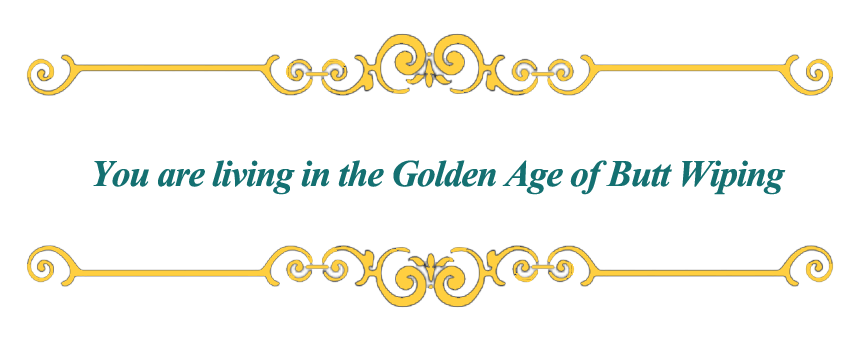
For nearly all of history, humans from all periods of time have wiped using the “closest smooth-ish object” method (i.e., identify the closest object that is relatively smooth and wipe). The Romans, Victorians, and even cowboys have had their fair share of using obscure tools to wipe. It was not until the recent introduction of toilet paper in the United States that we witnessed the widespread adoption of a product manufactured specifically for wiping the backside.
You will now embark upon a brief journey through some of the more popular (and fascinating) wiping methods over the centuries. On your journey, take some time to reflect on some of the deeper, unanswered questions in the Butt Wiping Cosmos: Where did rear end hygiene come from? And why has hygiene related to the least clean part of our bodies been so slow to develop?
Ancient Greece Hygiene
Ancient Greeks often used stones ("pessoi") or fragments of ceramic ("ostraka") to wipe.

Pessoi as wiping objects are found in Ancient Greek art, writings, and even proverbs. For example, an ancient Greek wine cup depicts a squatting man mid-wipe with a cane in one hand and a pessoi in the other.

As another example, the Ancient Greeks recited a proverb to emphasize being frugal, which roughly translates to “three stones are enough to wipe one’s arse.”
Some ceramic fragments used to wipe were inscribed with an individual’s names, which some believe indicates that Greeks were, quite literally, soiling the name of someone they did not like. This would be akin to our toilet paper printed with your favorite enemy’s face.
By modern standards, pessoi and ostraka would not be considered very hygienic, especially if you were frugally using only three. Some suggest that rough textures and sharp edges could have led to irritation and hemorrhoids. However, pessoi and ostraka represent an early widespread adoption of a single “accepted” wiping method – a collective agreement that particular objects were a good way to wipe, which can be considered an improvement from the “closest smooth-ish object” method.
Ancient Rome
Ancient Rome employed one of the most interesting wiping methods on our tour, what we at Pristine consider to be a low point in the history of human hygiene: the communal sponge-on-a-stick.

Public restrooms were often used to take care of business in large Roman cities. Ancient Roman “graffiti” has been found carved in the walls of public restrooms and reminds us that, though separated by thousands of years, humans are human. There were no toilet dividers, so it was not uncommon to see your neighbor during your daily movement. (here is a short video with some riveting information and visuals.)

You will notice that the Roman toilet opening extended downward in a keyhole shape, which allowed for insertion of the famed sponge-on-a-stick for wiping. Wealthy Romans could afford a personal sponge-on-a-stick, but many used (and re-used . . . and used again) the same communal sponge-on-a-stick. To “sanitize” the sponge after use, it was dunked into vinegar or salt water.
While, from a hygiene perspective, the communal sponge-on-a-stick may be a low point, the Ancient Romans are well known for improving toilet and plumbing technology in a way that would influence future civilizations for centuries.
Did Ancient Asia Invent Toilet Paper?
Ancient Asian cultures were known to use wooden sticks to wipe (also known as "poop sticks"). Wikipedia has an extensive listing on these “poop sticks,” which are known by many different names, including śalākā, cèchóu, and chūgi. These poop sticks have been uncovered in latrines along the Silk Road and have provided archaeologists with insight into ancient diet . . . and also ancient parasites. (You can learn more about the discovery of poop sticks on the Silk Road in this Smithsonian article.) The wooden sticks were thought to be inexpensive, washable, and reusable.
China is widely believed to have invented toilet paper. The first known historical reference to toilet paper was by Yan Zhitui who wrote in the 6th Century: “Paper on which there are quotations or commentaries from the Five Classics or the names of sages, I dare not use for toilet purposes.” Toilet paper was not known to be widely manufactured until the 14th Century in China and not until the 20th Century in the United States.
Early American
Stones, sponges-on-a-stick, and wooden sticks are all unique ancient wiping methods. However, throughout time, if a person did not have one of these wiping methods available, they would often resort to the tried and true “closest smooth-ish object” wiping method. The “closest smooth-ish object” wiping method was an early American favorite.
Early Americans used brick-lined “privy pits” as restrooms. This picture shows two privy pits at a tavern around the time of the Declaration of Independence. Not unlike modern bars, archaeologists uncovered much more than human waste from these early toilets, including drinking glasses, punch bowls, smoking pipes, liquor bottles, and even an entire window.
One of the more popular early American wiping objects was the dried corn cob.

A variety of other objects were also used, including leaves, handfuls of straw, and seashells.
As paper became more prominent and expendable, early Americans began using newspapers, catalogs, and magazines to wipe. Early readers of the Farmers’ Almanac began to nail a hole into the corner of the Almanac to hang on outhouse walls for the dual purpose of reading and wiping. In 1919, the Farmers’ Almanac began pre-drilling the legendary “hole,” and this vestige of early wiping habits can still be found drilled into the upper left-hand corner of the Farmers’ Almanac today.
Toilet Paper Patent
Patents related to toilet paper started to appear in the late 1800’s. Advocates of the "loose-end over" method point to the toilet paper patent about the "correct" way to put on a roll of toilet paper.

However, it was not until the early 1900’s that toilet paper began to be manufactured on a large scale in the form that we know it today.

It was presumably a challenging sell for early toilet paper titans – why would the public pay money for toilet paper when they had free newspapers, corn cobs, and straw out back? Marketing campaigns for toilet paper in the 1930’s boasted that toilet paper was “splinter free,” leaving us to infer that some earlier toilet paper in fact provided customers with free splinters.
When Did Toilet Paper Become Popular
Toilet paper dominated American bathroom hygiene during the 1900’s, even though wet wipes (originally known as “wet naps”) were invented in the 1950’s.
Wet wipes were not originally used for wiping the backside. The original Wet Nap products were first sold to Kentucky Fried Chicken (KFC) to wipe dirty hands.
It was not until the 1990’s that wet wipes became popular to wipe baby bottoms.

And, it was not until the last decade that wet wipes became popular among adults.
The Golden Age of Butt Wiping
This leads us to one shocking realization. Since the time that we wiped our hindquarters with corncobs and magazines, there have been just two major wiping innovations – toilet paper and wet wipes – the most “recent” originating 60 years ago.
To emphasize by comparison, in a world where companies launch a new cell phone at least once a year, there have been no major butt-wiping innovations in over half a century.
We may never answer the deeper questions of the Butt Wiping Cosmos. Perhaps rear end hygiene is stifled by the “out of sight, out of mind” anatomical positioning of our rears. Or maybe improved rear end hygiene is silenced by the stigma of bathroom talk.
Whatever the case, Pristine is here to offer you the third major bathroom hygiene innovation in the last century - toilet paper spray!





12 comments
In the eighteenth century, revolting though it may sound, gentlemen would wipe their arses with their shirt-tails and then tuck them in again! I’ll bet they were popular with the ladies on hot days when they wanted to lean in for a kiss!
Great read!!!!
Totally agree. Water is the most effective. Try wiping chocolate off your hands with toilet paper and see what’s left ‘behind’.
Before 1900, apparently stink was accepted as part of living?🦨🦨🦨🦨🦨
If it was not too cold outside , you can use snow. bring a bucket of snow and just scoop a handful and wipe. I imagine people used to do this. I use snow to clean things in the winter like my windshield and clean off oil and dirt under the hood . I also pee outside and clean my hands with snow.